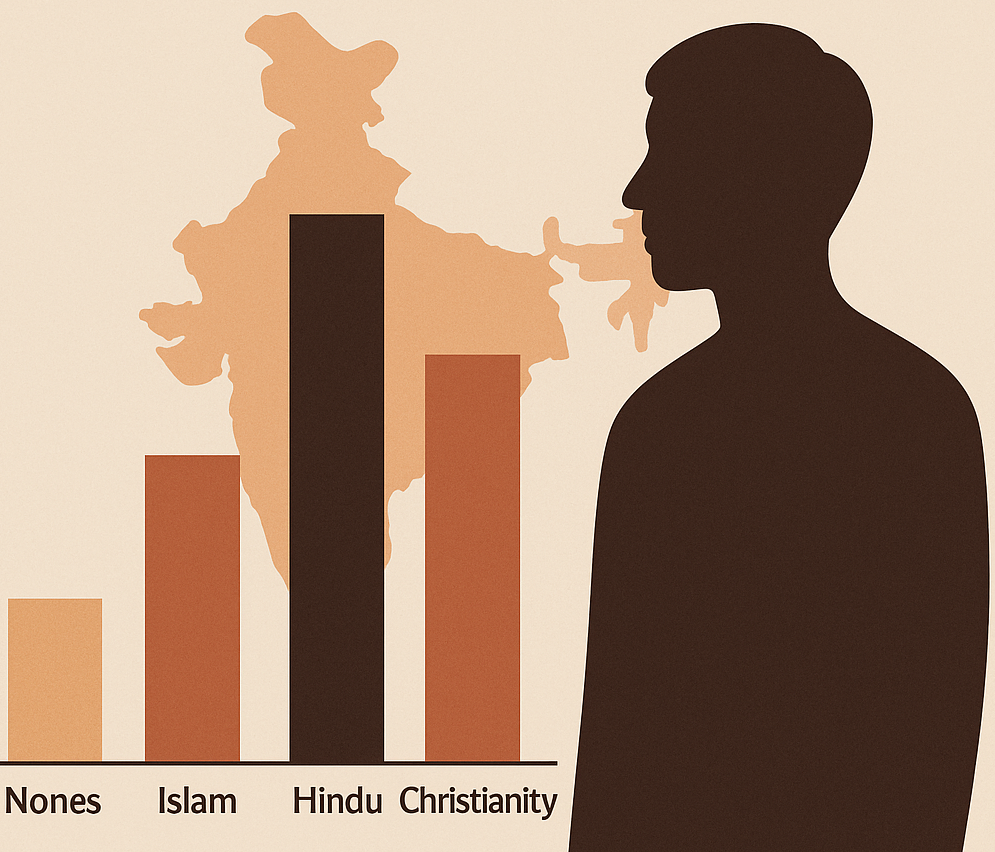The “Nones” (Religiously Unaffiliated) in India: Myth or Growing Reality?
In recent years, the term “Nones” — referring to people who claim no religious affiliation — has become a significant part of global discussions on faith and identity. In Western countries, particularly in Europe and North America, this group has grown rapidly. However, in India, where religion permeates every aspect of public and private life, the idea of being “religiously unaffiliated” seems almost unthinkable. But is it truly a myth, or could it be a quietly growing reality beneath the surface?
A Country Deeply Rooted in Faith
India’s social fabric has always been deeply intertwined with religion. Every aspect of life — from birth rituals to marriage ceremonies, festivals to death rites — carries a religious dimension. The Census of India in 2011 recorded that only 0.24% of the population, around 2.87 million people, identified themselves as having “no religion.” Similarly, a 2021 Pew Research Center survey found that less than 1% of Indians reported being religiously unaffiliated. These figures show that India remains overwhelmingly religious, with very little space for the “none” identity to exist publicly or statistically.
However, numbers do not always reveal the full story. In a country where identifying with a religion is often expected — socially, culturally, and even politically — many who personally feel distant from organized faith may still identify with one in official forms or social settings.
The Hidden Reality Behind Low Numbers
The low percentage of “nones” in India does not necessarily mean there is no shift happening. Several social and psychological factors may be hiding the real extent of non-affiliation. For one, there is still a social stigma attached to declaring oneself as having no religion. Religion in India is a marker of community, belonging, and moral character; rejecting it can often lead to alienation from family and society.
Another reason could be survey and census limitations. Many national surveys offer only fixed religious categories — Hindu, Muslim, Christian, Sikh, Buddhist, Jain, and “Other.” Even if a respondent feels detached from any religion, they may still tick the religion of their birth, simply because “none” is not a comfortable or familiar option.
The Seeds of Change
Despite the current data, some indicators suggest that a slow transformation could be emerging. Urbanization, digital exposure, and rising education levels have gradually begun reshaping young Indians’ attitudes toward religion. In cities like Bengaluru, Delhi, and Mumbai, one can observe growing communities of “spiritual but not religious” individuals — people who meditate, read philosophy, or practice mindfulness but avoid labeling themselves under any organized faith.
Social media has also given young Indians access to global ideas about secularism, atheism, and agnosticism. Online platforms host discussions, podcasts, and communities where questioning faith is no longer taboo. These virtual spaces have become safe havens for those who feel spiritually inclined but institutionally disillusioned.
Generation Z and the Quiet Revolution
Among India’s younger generations, particularly Generation Z, there is a subtle but noticeable shift from collective faith to personal spirituality. Unlike their parents, who saw religion as a community identity, many young people today see it as a personal or even optional matter. They might still visit temples or celebrate festivals, but they do so more out of cultural habit than deep conviction.
Moreover, interfaith friendships, mixed marriages, and exposure to global education have diluted rigid religious boundaries. For some, this leads not to conversion, but to non-affiliation — a quiet decision to remain unaligned rather than to switch from one faith to another.
Why “Nones” Are Still Rare
Still, calling the “nones” a major social group in India would be premature. Religion in India is more than belief; it’s community, culture, and identity. Even non-believers often participate in religious festivals for social reasons. Religious institutions also play vital roles in charity, education, and social support, keeping faith deeply relevant in daily life.
Politically, religion remains a strong mobilizing force, with public identity often linked to faith-based categories. Until religion’s role in defining social belonging and morality weakens, the unaffiliated will likely remain a small, silent minority.
Myth or Growing Reality?
At present, the idea of a large “none” population in India remains largely a myth. The numbers are too small to suggest a significant demographic trend. Yet, beneath the surface, societal changes are quietly paving the way for future growth. As cities expand, education spreads, and digital spaces encourage free thought, the number of Indians identifying as non-religious or unaffiliated may gradually rise in the coming decades.
The “nones” may not yet be a visible force, but they represent the early signs of a generational shift — one that values personal belief over institutional identity. Whether this group grows into a recognizable movement or remains a quiet undercurrent will depend on how open Indian society becomes to individuals choosing spirituality without religious labels.
the rise of “nones” in India is not a present-day reality but a potential future one. For now, faith continues to define the nation’s identity, but cracks are appearing in the wall of religious uniformity. The myth of the unaffiliated may soon turn into a modest but growing reality — a sign that India’s spiritual diversity is expanding, not shrinking.
~Religion World Bureau









